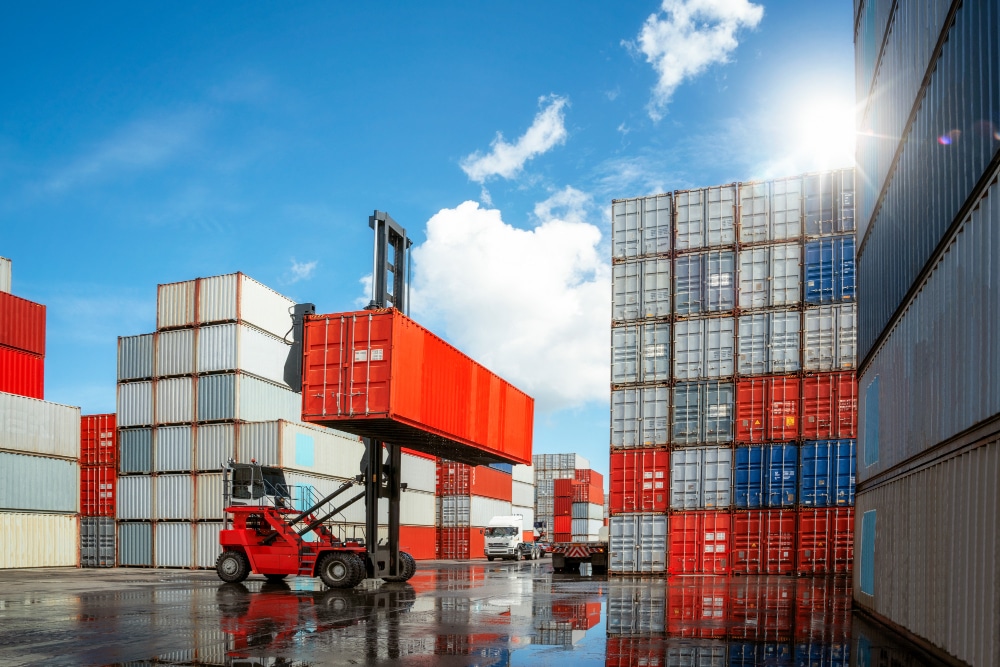With the advances in technology, e-commerce warehousing is quickly becoming an increasingly popular way of delivering goods from manufacturers to consumers.
With its efficiency and cost saving benefits, it’s no surprise that many businesses are beginning to adopt this process to improve their operations. But with any new endeavor, there can be obstacles and hiccups – which is why we created this guide!
Our ultimate guide to e-commerce warehousing will provide you with the necessary steps for efficient implementation of a warehouse program as well as key elements such as needs assessment, establishing metrics, and utilizing automation among other things to improve your e-commerce logistics.
From planning to budgeting all the way through to fulfillment – read on for all the details you need to start your journey towards modernizing with e-commerce warehousing today!
What Is E-commerce Warehousing?
E-commerce warehousing is a warehouse management system used to manage inventory in an online store. It includes digital storage and tracking, sorting, and delivering products purchased online.
Warehouses help businesses store and ship their goods more efficiently, allowing them to meet customer demand for faster shipping times. With an e-commerce warehousing system, companies can easily track their inventory from the time of order to delivery.
This helps minimize unnecessary costs by reducing errors and improving accuracy in customer orders. Additionally, warehouses enable businesses to reduce space requirements, save on labor costs, and improve inventory management systems.
E-commerce warehousing is a cost-effective way for businesses to manage their online inventory, ultimately leading to higher customer satisfaction.
In addition to managing inventory and orders, e-commerce warehousing systems can also provide helpful analytics. This data can help businesses optimize product offerings, pricing, and promotions.
It can also be used for forecasting future demand and identifying areas for cost savings. By leveraging this data, businesses can stay ahead of the competition and provide better customer service.
Why You Should Warehouse Your Ecommerce Products
Faster Shipping
If you’re looking for one compelling reason to warehouse your e-commerce products, consider this: faster shipping. By storing goods at a well-connected warehouse, you dramatically reduce shipping time and can get products out the door in record time.
This not only keeps customers happy with their speedy purchases but also frees up resources that can be devoted to scaling up the business.
Furthermore, you have total control of where products are stored and how they are handled, allowing you to offer an even better customer experience that customers will remember when they shop with your brand.
It’s Time Efficient
Warehousing your e-commerce products can be a huge benefit when it comes to time efficiency.
By having a warehouse, you no longer have to worry about establishing the various facets of a typical online store; instead, you can easily expense out and cut costs that would occur if such logistics are outsourced or implemented within an existing business structure.
With a warehouse, orders are fulfilled quickly upon request and delivery fees can be greatly reduced due to easy access for all of your customers.
Not only do warehouses help business owners save on time, but they also provide better customer experiences as customers get their buy items quickly and in one piece.
Warehousing is one of the most important things an e-commerce business can invest in if time saving is the goal.
Improved Control Of Inventory
If you’re looking for the most effective way to maintain control of your e-commerce inventory, warehousing proves to be the ideal solution. With a warehouse, your products can be easily accessed and managed – giving you more control over precisely how much product you have at any given time.
More importantly, warehousing ensures that you can meet customer demands swiftly while also preventing product overages and outages. With proper organization and labeling protocols in place, it becomes easy to monitor your stock levels and order accordingly.
Additionally, having quick access to inventory gives you a better understanding of what works best from a supply chain standpoint. It allows for smoother asset management, which ultimately leads to improved customer experience and increased profits.
Ultimately, warehousing gives you the necessary framework for managing your stock levels in a timely manner as well as improved control of inventory that is essential for E-commerce success.
Types Of E-Commerce Warehouses
Consolidated Warehouses
Consolidated warehouses are quickly becoming an attractive type of e-commerce warehouse thanks to their many advantages. They efficiently store products in one place, and have a higher cost efficiency than independent warehouses.
Consolidated warehouses have powerful automated systems for tracking merchandise, inventory and shipments.
Plus, in customer-facing services such as order fulfillment, delivery speed is a top priority but only with the help of consolidated warehouses can customers expect quick deliveries at relatively low costs.
All these factors result in improved operations and increased visibility for logistics making consolidated warehouses a great choice for both the seller and consumer alike.
Fulfillment Centers
Fulfillment centers are one of the most common types of e-commerce warehouses. These multilevel warehouses efficiently store goods that are involved with internet retailing; they are carefully designed to allow retailers to quickly achieve ready inventory status and ship their goods to customers around the world within a matter of hours.
For orders that require third-party logistics services, like express delivery, fulfillment centers employ additional personnel and technology to expedite the process.
This helps online merchants meet customers’ needs for maximum convenience, giving them an edge over competitors who may lack such resources but still struggle with same-day shipping times.
From innovative racks and automated systems to expert personnel on hand, fulfillment centers have established a reputable footprint as some of the premier e-commerce warehouses in today’s business market.
Public Warehouses
Public warehouses are an attractive e-commerce warehouse option for businesses that sell online, due to the high quality of service they offer. These third-party warehouses boast experienced staff, a variety of storage options, and high security measures.
These warehouses can store products on a short-term or long-term basis, and their services often go beyond simply storing goods – they can process orders, perform shipping and distribution duties, as well as providing pick-pack services.
Large public warehouses may also have state-of-the-art technology capabilities such as RFID sensors and barcode scanners.
The biggest downside to using public warehouses is the cost – pricing models can be complex, with costs varying greatly between different warehouses and service providers.
However, for companies in need of features like order fulfillment and expanded storage capacity that only a public warehouse could offer, this cost could be seen as worth it in the long run..
Consolidated Warehouses
Consolidated warehouses are a type of e-commerce warehouse that allows different retailers and businesses to store their inventory in one central location.
This type of warehouse is particularly beneficial for companies with multiple locations as it allows them to have a single storage site, reducing costs associated with individual storage spaces.
Consolidated warehouses specialize in timely order fulfillment, so customers can expect their orders to arrive quickly and accurately. Additionally, they utilize cutting-edge technology to monitor stock movements and efficiently handle customer demand.
These warehouses offer a wide range of services, from customized packing and delivery solutions to inventory management and product tracking services.
Consolidated warehouses provide businesses with the flexibility and convenience needed for successful e-commerce operations.
Which Ecommerce Warehouse Is Ideal For You?
The type of e-commerce warehouse you require depends on various factors such as size, budget, and desired services.
If you’re a small business with limited resources, then a public warehouse may be the best choice for your business due to its cost-effectiveness.
Large businesses or those that need to store sensitive items can benefit from using a fulfillment center with high-security measures.
A consolidated warehouse is the best option for companies with multiple locations or looking for an efficient ordering and shipping process.
Regardless of your needs, compare different e-commerce warehouses to ensure you get the most out of your investment. You can easily streamline your operations with the right warehouse and improve customer experience.
How To Manage An E-Commerce Warehouse
An e-commerce warehouse needs to be managed properly in order to ensure the smooth running of operations.
It is important to have a clear understanding of the different components and processes involved in managing an e-commerce warehouse, as well as being aware of any potential risks and challenges that may arise.
Create An Efficient Inventory System
The first step in managing an e-commerce warehouse is to create an efficient inventory system.
This should include keeping accurate records of stock levels, tracking the movement of goods within the warehouse and ensuring that all items are properly labeled and stored according to their type.
Additionally, it is important to set up a process for ordering new stock and monitoring existing inventory levels in order to avoid overstocking or running out of items.
Implement Safety Protocols
Another important component of managing an e-commerce warehouse is ensuring that the proper safety protocols are in place.
This includes making sure that all employees are wearing protective gear, using safe lifting techniques and adhering to fire safety regulations. It is also important to inspect any new equipment or products being delivered to the warehouse to make sure that it is safe to use.
It is also important to make sure that the e-commerce warehouse environment is organized and efficient. This includes keeping floors and shelves clear of clutter, organizing pallets and racks according to item type, and avoiding overloading storage areas.
Furthermore, proper ventilation should be maintained in the warehouse in order to reduce dust and allergens.
Establish Good Communication Channels
Finally, it is important to establish good communication channels between warehouse staff, customers and suppliers.
This is essential in order to ensure that orders are processed quickly and accurately, goods are delivered on time, and the customer is kept informed about any issues or delays.
Additionally, having a well-trained team of staff members who are knowledgeable about warehouse operations can help to ensure that the e-commerce warehouse is managed efficiently.
By taking all of these considerations into account, it is possible to successfully manage an e-commerce warehouse and ensure that operations run smoothly.
What To Look For When Setting Up A Warehouse For Your E-commerce Store
Determinate Space Needed
Setting up a warehouse for your e-commerce store requires careful thought, planning and analysis. One of the most important aspects of this process is determining the amount of space you need for storage.
To do this, you’ll need to consider the size and types of products you will be selling, their quantities, and how often they enter and leave your warehouse.
In addition to storage capacity, it’s important to keep in mind any additional space needed for unpacking/packing goods and storing packaging materials.
Consider whether or not your current supplier is capable of meeting your growth needs as well since nothing can be more frustrating than running out of warehouse space due to an unexpected spike in demand.
Finally, make sure there is ample room for ease of movement both inside and outside the facility – there’s no point having the prime spot if it ultimately isn’t functioning because staff members can barely navigate around it!
Implement The Right Warehouse Management Software
If you’re setting up a warehouse for your e-commerce store, one of the most important steps in the process is finding and implementing the right Warehouse Management Software (WMS).
A good WMS will allow you to easily track inventory, allocate space, pick orders, and manage shipments. It should also have real-time reporting capabilities so that you can monitor warehouse performance effectively.
Finding the best software for your warehouse operation is not an easy task — make sure that it meets all of your needs, can accommodate future growth and has customer service support.
With the right WMS in place, your warehouse team can increase efficiency and serve customers more quickly and efficiently.
Find How To Automate Processes
When setting up a warehouse for an e-commerce store, it’s important to consider how you can automate processes. Automation can ease the burden on employees and help to keep costs down.
Technology such as RFID readers and pick-to-light systems can be used in order fulfillment to make the process more efficient.
Automated inventory systems allow for real-time tracking of product quantities and useful analytics on demand levels, which help managers adjust stock levels when needed.
A warehouse management system can help with optimization by providing accurate information quickly, allowing organizations to streamline their operations.
In addition, robots and automated guided vehicles can be used to reduce time spent handling products.
Making use of automation improves accuracy and enhances customer satisfaction, helping companies provide better service while increasing profits.
Integrate Your Existing Systems
One key area that should not be overlooked is integrating existing systems. Most stores have accounting, order management, and shipping solutions already in place – all of which need to connect with the new warehouse system.
Therefore, it is crucial to research whether the software you select has high-quality APIs for connecting systems and will work well with your existing systems before committing to a solution.
Doing so will ensure that there are no last minute problems when it comes time to set up the warehouse and go live with your store.
Manage Your Ecommerce Warehouse With Detrack
E-commerce warehousing has come a long way since its inception and continues to evolve as technologies and trends also change. By implementing effective procedures and making use of the available resources, businesses can significantly improve their warehousing operations in the digital sphere.
This guide has hopefully provided a comprehensive understanding to help you achieve this. With adequate planning and expertise, there is no limit to how successfully you can leverage an e-commerce warehouse.
If readied properly, this could open up your business to unprecedented growth opportunities. So what are you waiting for? Embrace all that a sound warehousing solution has to offer today by creating an account with Detrack.


























